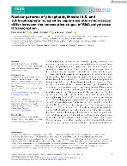Nuclear patterns of phosphatidylinositol 4,5- and 3,4-bisphosphate revealed by super-resolution microscopy differ between the consecutive stages of RNA polymerase II transcription

Publication date
2024Published in
FEBS JournalVolume / Issue
291 (19)ISBN / ISSN
ISSN: 1742-464XISBN / ISSN
eISSN: 1742-4658Metadata
Show full item recordCollections
This publication has a published version with DOI 10.1111/febs.17136
Abstract
Phosphatidylinositol phosphates are powerful signaling molecules that orchestrate signaling and direct membrane trafficking in the cytosol. Interestingly, phosphatidylinositol phosphates also localize within the membrane-less compartments of the cell nucleus, where they participate in the regulation of gene expression. Nevertheless, current models of gene expression, which include condensates of proteins and nucleic acids, do not include nuclear phosphatidylinositol phosphates. This gap is partly a result of the missing detailed analysis of the subnuclear distribution of phosphatidylinositol phosphates and their relationships with gene expression. Here, we used quantitative dual-color direct stochastic optical reconstruction microscopy to analyze the nanoscale co-patterning between RNA polymerase II transcription initiation and elongation markers with respect to phosphatidylinositol 4,5- or 3,4-bisphosphate in the nucleoplasm and nuclear speckles and compared it with randomized data and cells with inhibited transcription. We found specific co-patterning of the transcription initiation marker P-S5 with phosphatidylinositol 4,5-bisphosphate in the nucleoplasm and with phosphatidylinositol 3,4-bisphosphate at the periphery of nuclear speckles. We showed the specific accumulation of the transcription elongation marker PS-2 and of nascent RNA in the proximity of phosphatidylinositol 3,4-bisphosphate associated with nuclear speckles. Taken together, this shows that the distinct spatial associations between the consecutive stages of RNA polymerase II transcription and nuclear phosphatidylinositol phosphates exhibit specificity within the gene expression compartments. Thus, in analogy to the cellular membranes, where phospholipid composition orchestrates signaling pathways and directs membrane trafficking, we propose a model in which the phospholipid identity of gene expression compartments orchestrates RNA polymerase II transcription.
Keywords
gene expression, nuclear architecture, nuclear speckles, nucleoplasm, quantitative direct stochastic optical reconstruction microscopy dSTORM
Permanent link
https://hdl.handle.net/20.500.14178/2590License
Full text of this result is licensed under: Creative Commons Uveďte původ 4.0 International







